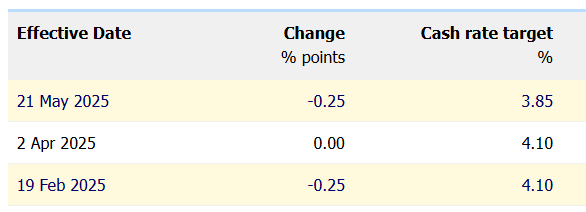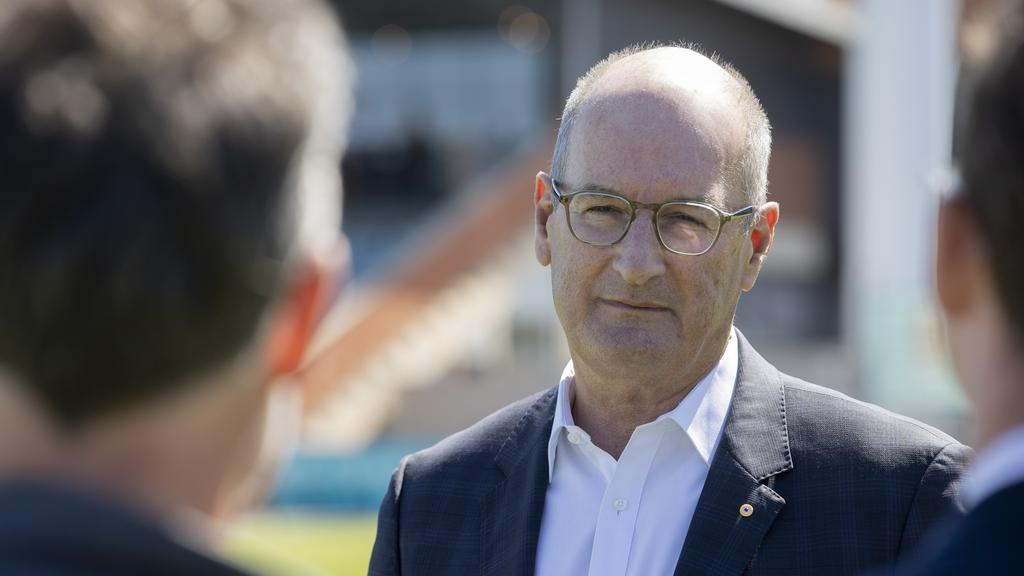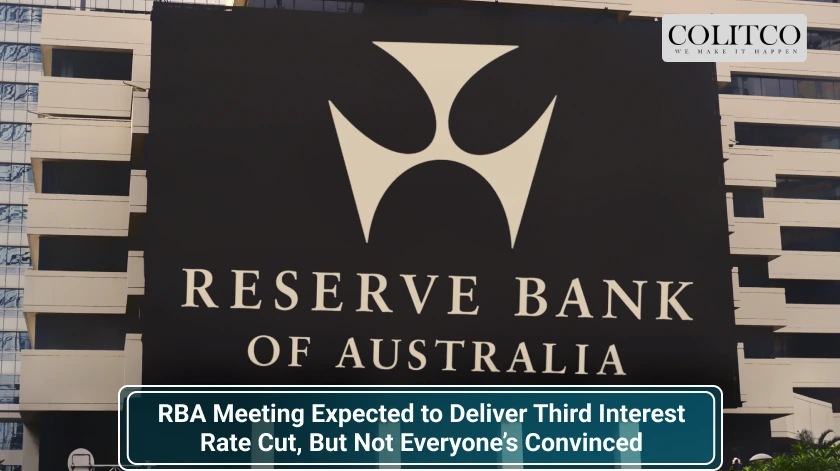The Big Decision Looms
As the RBA meeting kicks off, anticipation is high across markets, households and business sectors. The Reserve Bank of Australia’s two-day board meeting is expected to culminate in its third RBA interest rate cut of the year, with economists and traders largely forecasting a 25 basis point reduction that would bring the cash rate down to 3.6 per cent.
The overwhelming consensus has formed on the back of softer inflation data, with May’s consumer price index easing to 2.4 per cent—the lowest level in nearly four years. This fall in inflation has strengthened the case for an interest rate cut, giving borrowers hope for much-needed relief.

The RBA has already made two rate cuts this year. [Reserve Bank of Australia]
Economists Lean In—But Not All
According to The Australian Financial Review’s quarterly survey, 32 out of 36 economists expect the RBA to cut rates at this RBA meeting. Yet, a few outliers remain unconvinced. Notably, Citi, Bank of America, Betashares, Morgans Financial, and Macroeconomics Advisory believe the RBA might hold steady for now.
Citi’s chief economist Josh Williamson said the central bank should wait until it receives more data: “We would prefer to see the RBA keep the cash rate unchanged in July and instead wait for the complete Q2 CPI data, updated staff activity forecasts and business liaison before cutting again.”
He emphasised the need for a cautious approach: “The Australian economy doesn’t need such a fast pace of easing… particularly when the hiking cycle was protracted and the cash rate peak below that of central bank peers.”
Bank of America’s Nick Stenner echoed this sentiment, pointing to lingering inflation concerns. “Underlying inflation is at the top of the band and not expected to hit the target midpoint before mid-2027,” he said. “The RBA will not necessarily be pushed into cutting to validate market pricing.”
A Financial Lifeline for Borrowers
If the RBA interest rate cut decision is taken at the RBA meeting, millions of Australians stand to benefit. A 0.25 percentage point reduction would save an average mortgage holder around $76 per month on a $500,000 home loan. For some, it’s a small win amid broader financial pressure.
Sydney entrepreneur Nia Pandoulis, who runs Soult Australia, said a lower rate would be a welcome boost: “I think lower interest rates would help us as businesses, and our customers. Consumers would have more confidence in what they’re buying, and we’d benefit without those additional costs.”
Ms Pandoulis hopes lower borrowing costs will help expand her fashion business—and eventually make home ownership more achievable. But she’s also wary of the broader economic reality: “I think the reality of owning a home in Sydney is getting pushed further and further out.”

Cheaper borrowing, according to Nia Pandoulis, is the best strategy for expanding her brand, Soult Australia’s market share. [Image: Soult]
Why the RBA Might Pause
While inflation has eased, economic risks persist. Citi and Macroeconomics Advisory suggest that the RBA may want to wait for more labour market softening before pulling the trigger on another cut. Stephen Anthony, chief economist at Macroeconomics Advisory, warned against premature easing: “There is what the RBA should do and what it will do. We would argue that they should wait and see whether Australian labour markets soften over the next two quarters.”
Indeed, while GDP growth in Q1 was weak, some argue this masks stronger private demand, and unemployment remains low. The RBA may fear reigniting inflation by easing too soon.
The Consumer Response: Save, Don’t Spend
Despite previous rate cuts, consumer spending has remained subdued. Belinda Allen, a senior economist at the Commonwealth Bank, observed that many Australians have chosen to save or pay down debt instead of spending. “We’ve been waiting for this to shift, and it looks like it’s taking longer than we expected,” she said.
AMP’s internal data also shows that inflation may have eased, but spending hasn’t surged in response. This trend could give the RBA room to move more aggressively with future cuts, especially if inflation remains under control and external risks, like global trade tensions, intensify.
Four Cuts on the Horizon?
AMP’s deputy chief economist Diana Mousina believes the RBA is on track for multiple cuts this year. “We do think that the Reserve Bank is going to keep cutting interest rates,” she said. AMP is forecasting as many as four cuts in total: three this year and one more in early 2026, potentially lowering the cash rate to 2.85 per cent.
This level, she said, would bring the rate closer to the “neutral” setting where the RBA believes monetary policy neither stimulates nor slows down the economy.
Property Prices Set to Climb
While rate cuts are a relief for existing homeowners, they may create new challenges for first homebuyers. Falling rates usually translate to rising property prices. As Eliza Owen from Cotality observed, “A reduction in interest rates is kind of like a price cut on the cost of debt… that increases the maximum people can borrow for mortgages, and that means property values usually move higher.”
Property markets in cities like Darwin, Sydney, Melbourne and Brisbane have already seen price rises of 2 to 6 per cent since earlier rate cuts, and further easing may push them even higher.
Emotional Toll and Economic Caution
David Koch, economic director at Compare the Market, warned that financial stress remains high, despite potential relief. “Nearly half of Aussies are now reporting mental health struggles due to financial stress,” he said. The firm’s recent research showed that 48.7 per cent of Australians felt heightened anxiety or depression from money pressures, with Gen Z and Millennials most affected.
Still, Koch acknowledged the RBA now has the “green light” to act in the RBA meeting: “The May CPI figures were better than expected, and household budgets remain tight.”

Compare the Market’s economics director, David Koch, has cautioned that Australians could face serious consequences if the RBA delays action. [Credit: Brett Hartwig]
All Eyes on Tuesday
The RBA meeting outcome on Tuesday at 2:30 pm AEST will be pivotal. While the bond market has priced in a 95 per cent chance of a cut, and all big four banks forecast it, the final decision lies with the RBA board.
Also Read: NAIDOC Week 2025 Celebrates Strength, Vision and Legacy: Full List of Winners
Whether the RBA acts now or waits for more data, the decision will shape mortgage repayments, property prices, and household confidence for months to come.
For now, Australians watch and wait.












